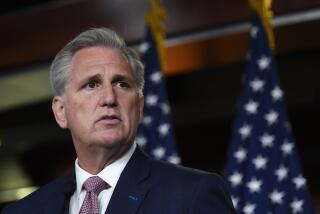A More Honest Approach
- Share via
Congress is challenging President Bush regarding the funding for his plan to bail out the ailing savings and loan industry, and a welcome challenge it is. The House Ways and Means Committee has adopted a proposal that would save taxpayers an estimated $4.5 billion over the next 30 years. And it has the additional virtue of dealing more directly and more honestly with the deficit in the federal budget.
The congressional action has drawn a threat of presidential veto from Treasury Secretary Nicholas F. Brady, who seems more concerned with preserving an illusion of reducing federal costs than in the real savings inherent in the congressional plan. Brady is right in sticking firmly to the strict financial rules proposed in the original savings and loan bailout plan that he devised for the Bush Administration. But he is wrong in hiding the plan’s real cost.
Some Republicans as well as the great majority of the Democrats in Congress want to place the bailout where it belongs, on the budget, for everyone to see, even though it would immediately pose a problem in meeting the mandates of the Gramm-Rudman-Hollings legislation on reducing the deficit. The implication is that the President would be faced with revenue needs at a time when he insists that there is no need for additional revenue.
But the Bush proposal would cost more, not less, no matter how he conjures the bookkeeping. Brady has proposed funding the bailout by creating a new entity that would issue its own bonds to raise the funds, a maneuver that keeps the transaction off budget. In the long run, however, the taxpayers would end up paying more, not less.
More to Read
Get the L.A. Times Politics newsletter
Deeply reported insights into legislation, politics and policy from Sacramento, Washington and beyond. In your inbox twice per week.
You may occasionally receive promotional content from the Los Angeles Times.










